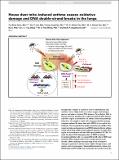House dust mite-induced asthma causes oxidative damage and DNA double-strand breaks in the lungs
Author(s)
Chan, Tze Khee; Loh, Xin Yi; Peh, Hong Yong; Tan, W.N. Felicia; Tan, W.S. Daniel; Li, Na; Wong, W.S. Fred; Engelward, Bevin P; Tay, Jun Jie Ian; ... Show more Show less
Downloadmain article (5.003Mb)
PUBLISHER_CC
Publisher with Creative Commons License
Creative Commons Attribution
Terms of use
Metadata
Show full item recordAbstract
Background
Asthma is related to airway inflammation and oxidative stress. High levels of reactive oxygen and nitrogen species can induce cytotoxic DNA damage. Nevertheless, little is known about the possible role of allergen-induced DNA damage and DNA repair as modulators of asthma-associated pathology.
Objective
We sought to study DNA damage and DNA damage responses induced by house dust mite (HDM) in vivo and in vitro.
Methods
We measured DNA double-strand breaks (DSBs), DNA repair proteins, and apoptosis in an HDM-induced allergic asthma model and in lung samples from asthmatic patients. To study DNA repair, we treated mice with the DSB repair inhibitor NU7441. To study the direct DNA-damaging effect of HDM on human bronchial epithelial cells, we exposed BEAS-2B cells to HDM and measured DNA damage and reactive oxygen species levels.
Results
HDM challenge increased lung levels of oxidative damage to proteins (3-nitrotyrosine), lipids (8-isoprostane), and nucleic acid (8-oxoguanine). Immunohistochemical evidence for HDM-induced DNA DSBs was revealed by increased levels of the DSB marker γ Histone 2AX (H2AX) foci in bronchial epithelium. BEAS-2B cells exposed to HDM showed enhanced DNA damage, as measured by using the comet assay and γH2AX staining. In lung tissue from human patients with asthma, we observed increased levels of DNA repair proteins and apoptosis, as shown by caspase-3 cleavage, caspase-activated DNase levels, and terminal deoxynucleotidyl transferase–mediated dUTP nick end-labeling staining. Notably, NU7441 augmented DNA damage and cytokine production in the bronchial epithelium and apoptosis in the allergic airway, implicating DSBs as an underlying driver of asthma pathophysiology.
Conclusion
This work calls attention to reactive oxygen and nitrogen species and HDM-induced cytotoxicity and to a potential role for DNA repair as a modulator of asthma-associated pathophysiology.
Date issued
2016-05Department
Massachusetts Institute of Technology. Department of Biological EngineeringJournal
Journal of Allergy and Clinical Immunology
Publisher
Elsevier
Citation
Chan, Tze Khee; Loh, Xin Yi; Peh, Hong Yong; Tan, W.N. Felicia; Tan, W.S. Daniel; Li, Na; Tay, Ian J.J.; Wong, W.S. Fred and Engelward, Bevin P. “House Dust Mite–induced Asthma Causes Oxidative Damage and DNA Double-Strand Breaks in the Lungs.” Journal of Allergy and Clinical Immunology 138, no. 1 (July 2016): 84–96.e1 © 2016 American Academy of Allergy, Asthma & Immunology
Version: Author's final manuscript
ISSN
0091-6749